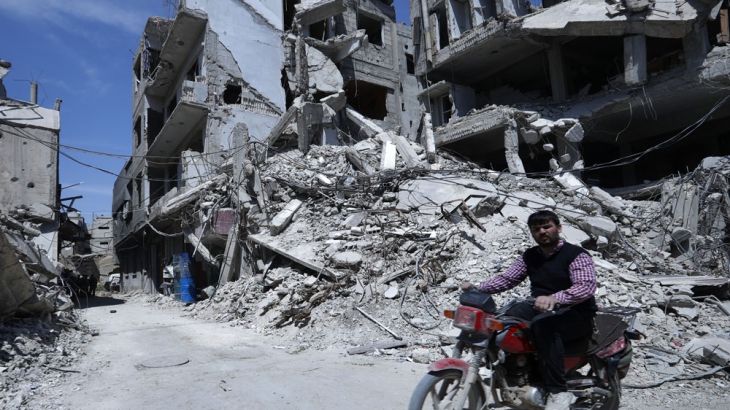Chemical weapons inspectors reach Douma to probe gas attack
A week after arriving in Syria, experts enter town where dozens died and hundreds were injured in April 7 incident.

Inspectors from the global chemical weapons watchdog have finally reached a formerly rebel-held town in Syria where a suspected gas attack took place two weeks ago.
Saturday’s visit to Douma came a week after the fact-finding mission of the Organisation for the Prohibition of Chemical Weapons (OPCW) first arrived in Syria, and amid growing questions about whether there would still be enough evidence for the investigators to gather.
In a statement, the OPCW said its team had visited one of the sites of the alleged attack to collect samples for analysis.
“The OPCW will evaluate the situation and consider future steps including another possible visit to Douma,” it said.
“Based on the analysis of the sample results as well other information and materials collected by the team, the FFM (fact-finding mission) will compile their report for submission to the States Parties to the Chemical Weapons Convention for their consideration.”
Earlier on Saturday, the foreign ministry of Russia, a major ally of Syrian President Bashar al-Assad, had also said that the OPCW inspectors had entered Douma.
The US and France have accused Russia of blocking access to the site, where rescuers and medics say dozens of people were killed on April 7.
The Syrian government and Moscow say the alleged chemical attack, which prompted a series of air strikes by Western allies as an act of retaliation, was staged.
Security fears
The OPCW team arrived in Damascus on Saturday but had not been able to travel to Douma, on the outskirts of the capital, due to security concerns following a reconnaissance mission by a United Nations team at two sites in the town on Tuesday.
The UN Department of Safety and Security (UNDSS) officials had to withdraw from the first location as the presence of large crowd there raised security fears.
At the second site, they came under small arms fire and an explosive device was detonated nearby, the OPCW said in a statement.
|
|
There were no injuries and the UN team returned to Damascus, but the watchdog had to postpone its visit.
In a statement on Saturday, Maria Zakharova, spokesperson for the Russian foreign ministry, said the delays to the OPCW team were “unacceptable”.
On Monday, during an emergency meeting at the OPCW’s headquarters in The Hague, Western diplomats accused the Syrian government and Moscow of obstructing the team.
Russia denied the claims, saying parts of Douma still needed to be de-mined and said the watchdog’s inspectors would enter on Wednesday.
Yet, France and the US appeared to question the purpose of such a mission, warning at the time that any incriminating evidence had likely been removed by then.
Earlier this week, Ishak Majali, a former OPCW inspector, said it was unlikely the inspectors would find evidence at the site after such delay.
“It has been a lot of time since the attack took place,” he told Al Jazeera.
“So, if you are in control of a site with chemicals for such a long time, it’s very easy actually to tamper with the place and to change the facts on the ground.
“You can actually do what we call it in the military business as the decontamination process, which is to remove all the evidence on the ground by using other chemicals to neutralise the chemicals on the ground. Also, you can tamper with the munition itself … to prepare some witnesses or to prepare some medical reports.”
Government raids
The town of Douma was under rebel control and facing a government air and ground assault when the suspected attack took place.
Images that emerged from Douma at the time showed lifeless bodies collapsed in crowded rooms, some with foam around their noses and mouths.
Opposition groups gave up the town in the days after the incident. Thousands of people – rebels and civilians – left on buses to northern Syria, believing they could not reconcile with the government after it took over the town.
The evacuations were the latest in a string of population transfers around the Syrian capital that have displaced more than 60,000 people as the government reconsolidates control after seven years of civil war.
|
|
UN officials and human rights groups say the evacuations amount to a forced population displacement that may be a war crime.
Also on Saturday, Syrian government forces continued an offensive against rebel-held parts of the capital’s outskirts, in a bid to drive out remaining armed opposition groups, according to state media and war monitors.
Rebel-held pockets near Damascus have been witnessing intense bombardment and shelling from Assad’s forces since Thursday.
Some of the areas, including Hajar al-Aswad and Tadamun in the southern district of Damascus, have been under Islamic State of Iraq and the Levant (ISIL, also known as ISIS) group’s control since April 2015.
The areas comprise the majority of the Palestinian Yarmouk refugee camp, which lies about 8km from central Damascus.